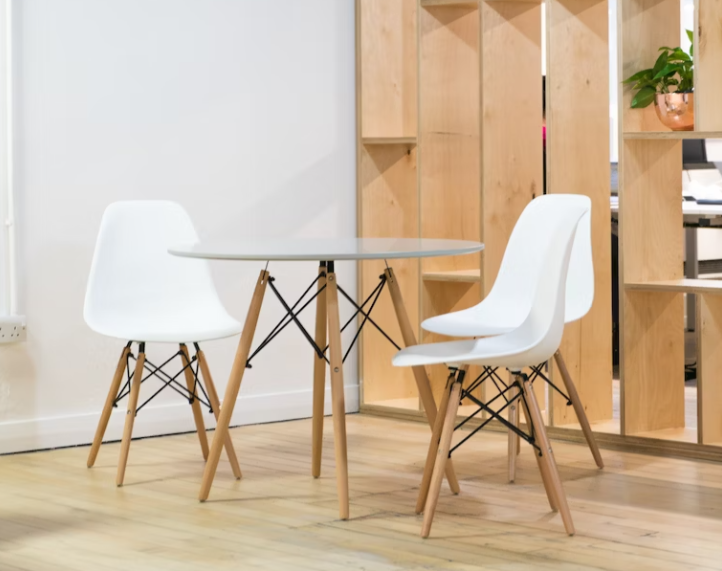How to make furniture using bamboo is a craft that I’ve come to love over the years. I always appreciated the unique and stylish touch that bamboo furniture brings to a room but never realized how easy it is to produce. I stumbled upon the art of making bamboo furniture during a trip and was immediately drawn to the craft’s simplicity and eco-friendliness.
Whether you’re a seasoned woodworker with ample experience or a DIY beginner, with a bit of time and patience, you too can produce stunning bamboo furniture pieces that will elevate your home décor. So, let’s dive into how to make furniture using bamboo and create something beautiful!
Why is Bamboo an Ideal Material for Making Furniture?

When it comes to furnishing your home, there are many materials to choose from, but have you ever considered bamboo? While bamboo has long been used in Asian cultures for various purposes, it is also growing in popularity for home decor. Here are the many benefits of bamboo furniture and why it is an ideal choice for your home.
1: Environmentally Friendly
One of bamboo furniture’s biggest benefits is it’s environmentally friendly. Bamboo is one of the fastest-growing plants in the world, and it can grow up to three feet in just 24 hours. It makes it a sustainable and renewable resource. Unlike hardwoods which can take decades to grow, bamboo only takes five to six years to mature, making it an ideal choice for eco-conscious homeowners.
2: Durability
Not only is bamboo sustainable, but it is also highly durable. Bamboo is as strong as steel and more durable than hardwoods like oak, maple, or cherry. Due to its strength and durability, bamboo furniture is resistant to scratches, dents, and even water damage. It is also less likely to warp or crack over time, making it an ideal choice for furniture that lasts many years.
3: Easy to Clean
Bamboo furniture is excellent for those who enjoy low-maintenance living! Its natural hardness makes it more resistant to stains and daily debris than other materials. With simple cleaning solutions like soap and water, you can easily eliminate unwanted spots and maintain your furniture’s natural beauty.
4: Versatility
Bamboo furniture is not only environmentally friendly, durable, and easy to clean, but it is also versatile. You can find bamboo furniture in various styles and colors to suit your home’s decor. Whether you are looking for a modern or traditional look, there is a bamboo furniture piece that will fit your style.
5: Affordability
Compared to hardwood flooring, bamboo furniture is also very affordable. While hardwood is relatively expensive, bamboo furniture is much more affordable, making it an ideal choice for budget-conscious homeowners. Bamboo furniture is also relatively low-maintenance, so you won’t have to spend extra money on maintenance or repairs.
By choosing bamboo, you are putting your money into a product that will last many years and benefit the environment.
Essentials Tools Needed for Bamboo Furniture Making
If you already have a design in mind, the next step is to know the tools you’ll need to bring your project to fruition. Fortunately, bamboo furniture-making is easy and enjoyable; you don’t need heavy machinery or exotic equipment to pull it off. You just need some essential tools needed for this project.
🔨Knife
A sharp and sturdy knife is necessary when cutting bamboo. A quality knife will make the process easier and safer. Look for knives that have stainless steel blades and comfortable handles. Brands like Opinel or Higo are good quality knives to consider. You can check out online shops or your local hardware store.
🔨Hand Saw
For cutting, shaping, and trimming bamboo- a hand saw will do the job just fine. Choose a saw with a sharp blade and comfortable handle. Blades with small teeth are best for cutting bamboo since they offer better control. Many saw types are available, such as a hack saw, coping saw, or folding saw. Choose the one that feels comfortable for you to use.
🔨Chisel
A chisel is vital for cutting chamfers, sharpening tenons and mortises, and carving decorative patterns on bamboo. A sharp chisel that fits comfortably in your hand is preferable. The most common type of chisel you’ll need for this project is the beveled edge chisel. Narex or Two Cherries are good brands to consider.
🔨Hammer or Mallet
The hammer is used with the chisel to cut tenons and mortises and join bamboo pieces. On the other hand, the mallet is a better alternative to the hammer since it applies less force and tends to absorb shock better. You can choose the one that feels more comfortable in your hands. A claw hammer or a rubber mallet will work.
🔨Marking and Measuring Tools
These tools ensure you produce the correct dimensions and cuts for your bamboo furniture. Quality tools are tape measures, rulers, protractors, marking gauges, and scribers. A Torpedo level will help you make sure everything is leveled and straight. Look for brands like Stanley or Mitutoyo for quality marking and measuring tools.
With the essential tools listed above, you can easily make quality bamboo furniture. Always consider the quality when purchasing tools, and if you need help deciding which tool to pick, feel free to ask for expert advice. You can find quality tools in your local hardware stores or online shops.
Step-by-Step Guide on How to Make Furniture Using Bamboo

Now that you have the tools, it’s time to start making furniture with bamboo. So let’s start with bamboo chairs since it’s the most basic furniture project.
📌Prepare the Bamboo
Preparing bamboo is crucial to making bamboo chair furniture. Getting this step right is essential since it sets the foundation for producing high-quality bamboo furniture.
Step 1: Choose the Right Bamboo
The first step in preparing the bamboo is choosing the right stalks. Generally, older stalks are harder and more durable than younger ones. Younger stalks are flexible and ideal for furniture design with curves. You can also determine the best bamboo for chair furniture by checking the thickness and density of the stalks. You need to select stalks that are uniform in diameter, without cracks, and have a straight form. Once you’ve selected the ideal stalks, you can move to the next preparation phase.
Step 2: Cut the Bamboo
The second key step is to cut the bamboo to the right size. Before cutting, ensure no insects, bumps, or dents on the stalks. Use a sharp saw or machete to cut the bamboo precisely and evenly. Making accurate cuts for even chair legs and armrests is essential.
Step 3: Soak the Bamboo
After cutting the bamboo, the next step is to soak it to soften the inner fibers. This makes it easier to work with the bamboo stalks. Soaking will also allow you to straighten the bamboo if it has some curvature. Fill a tub with water and put the bamboo stalks inside, adding some weight to push the stalks down. Leave the bamboo to soak for 3 to 4 days. Check it regularly, and top up the water if needed.
Step 4: Dry the Bamboo
Once you’ve soaked the bamboo stalks, it’s time for them to dry. Spread the bamboo stalks out in a well-ventilated area in the sun or wind without any exposure to moisture or rain. This process may take several days to complete. Ensure that the bamboo stalks are completely dry before making the chairs.
Step 5: Sand the Bamboo
The final step in preparing bamboo for use in making chairs is sanding. Use a sanding machine or sandpaper to smoothen the bamboo stalks and remove any rough edges or bumps. When you finish the sanding process, your bamboo stalks will be ready to use for any bamboo chair furniture design.
📌Assemble the Pieces
Assembling the pieces is an important part of furniture-making. Even if you have the best materials, if you don’t put them together correctly, your project will not look as good as you want.
Step 1:
First, let’s start with the seat of the chair. Take the bamboo strips you prepared in the previous step and lay them flat on a work surface. Arrange them so that the strips cover a square area, ensuring that the ends of the strips are even. Once you are satisfied with the arrangement of the strips, carefully slide them together. You can use clamps or masking tape to keep them in place while you work.
Step 2:
Next, connect the vertical pieces of the chair. Line up the two front legs and two back legs, and then use a long bamboo strip to connect them. Insert the bamboo strip into the pre-drilled holes on the legs and secure it in place by tying a knot. You can also add extra support by using a thin bamboo strip to connect the legs on both sides of the chair.
Step 3:
Now it’s time to connect the horizontal pieces to the chair frame. Start with the backrest. Take a bamboo stick and tie it to the back legs of the chair frame, about 12 inches above the seat. Tie a knot using a strong twine or string to ensure it is secure. Then, tie two more bamboo sticks to the bottom of the backrest, making an “X” shape. These will serve as support for the backrest.
Step 4:
Connect the front and back legs of the chair by using another bamboo strip. You can drill holes in the legs beforehand to make it easier to insert the bamboo strip. Be careful not to damage the bamboo strips you use as the seat. Once you have connected the front and back legs, attach the seat to the frame by inserting the bamboo strips into the holes in the legs.
Step 5:
Add the armrests to the chair. Place your pre-cut bamboo pieces on both sides of the chair, ensuring they are even and at the same height. Use a stronger bamboo piece to connect the armrests to the chair frame, making sure it is tied securely. Once everything is in place, check if the chair is stable and level.
📌Cutting & Sanding
When it comes to cutting bamboo, using a fine-toothed saw is recommended. This tool allows you to make precise cuts and avoid causing any damage to the bamboo piece. Remember to mark your cuts beforehand to ensure precision. For thicker bamboo pieces, using a hand saw would be ideal. Checking if the bamboo pieces are aligned before making the cut is essential.
After cutting the bamboo to your desired size, it’s time to sand it. Sanding is crucial to prevent rough edges and splinters. Using sandpaper with grits ranging from 80 to 220 for smoother edges is advisable. An electric sander would significantly save time and effort, especially when sanding large bamboo pieces. Hold the bamboo piece firmly to get even sanding all around when sanding.
Another tool to consider when sanding is a rotary tool. Specifically, a Dremel tool allows you to carve out intricate designs. These tools can rotate at high speed and have a variety of attachments that you can use to achieve different finishes. Adjust the speed according to the wood’s hardness to avoid damaging it.
When rounding the edges of your bamboo pieces, here’s a tip: use a router. A regular router allows you to cut different profiles on wooden pieces. It can come in handheld or table-mounted forms. With this tool, you can round the edges of your bamboo pieces to avoid sharp edges.
Moreover, a chisel can be helpful when making intricate cuts in the bamboo. To use a chisel correctly, hold the bamboo piece firmly with the non-dominant hand while holding the chisel with the dominant hand. Make sure you’re using a sharp chisel to avoid damaging the bamboo piece, and always work in a well-lit area.
📌Finishing Touches
For the bamboo chair to last longer, it is vital to give it a finishing touch. Applying a sealant or varnish adds an extra protective layer to make your furniture more durable, polished, and resistant to stains, scratches, or moisture.
Step 1: Get the Right Sealant or Varnish
In order to start, you must choose the right sealant or varnish. Different types of sealants are available in hardware stores, and you can opt for either water- or oil-based varnish. Water-based varnish is ideal for indoor furniture because it is easy to clean and eco-friendly. Meanwhile, oil-based varnish is ideal for outdoor furniture because it resists heat, weather, and moisture. I prefer using polyurethane varnish for my bamboo chair furniture, as it provides a hard, glossy finish that is easy to maintain. Ask the salesperson at the hardware store for the specific varnish that is safe to use on bamboo materials.
Step 2: Prepare the Surface
Before applying the sealant, preparing the surface of your bamboo chair furniture is crucial. Sand the surface with fine-grit sandpaper, starting from rough to finer grains. This process helps remove any rough spots or splinters and smooth the surface. Wipe the surface clean with a damp cloth, and let it dry for at least an hour before applying the sealant.
Step 3: Apply the Sealant
Using a foam brush or soft-bristled paintbrush, apply the sealant evenly on the surface of the bamboo chair furniture. Avoid applying too thick of a layer, as it may take longer to dry and can leave marks or drips. If using polyurethane varnish, apply at least three coats, allowing each coat to dry for three to four hours before applying the next coat. Lightly sand the surface between each coat with fine-grit sandpaper to remove any rough spots or inconsistencies. If you want to enhance the color of your bamboo chair furniture, you can apply a tinted or colored varnish as well.
Step 4: Let it Dry
After applying the final coat, let the bamboo chair furniture dry completely. You can leave it overnight or for at least 24 hours before using it. Ensure the furniture is in a well-ventilated area while it dries, and avoid exposure to direct sunlight or moisture.
Step 5: Buff it up
Once your bamboo chair furniture is completely dry, you can buff it up to bring out its shine. Use a soft cloth or a buffing pad attached to a drill to buff the surface evenly. This step is optional, but it adds an extra layer of protection and enhances the finish of your bamboo chair furniture.
There you go! Your bamboo chair furniture is now ready for use.
Frequently Asked Questions
What are the steps in bamboo craft making?
Bamboo is grass that can grow up to 100 feet tall, making it ideal for various crafts and furniture pieces. In order to make bamboo crafts, the first step is to harvest the bamboo. Once the bamboo is harvested, it’s left to dry for a few days. Afterward, the dried bamboo is cut into the desired size and shape. The next step is to shape the bamboo using sandpaper and other tools. Once the bamboo is shaped, you can use it to create various crafts such as baskets, picture frames, and wall art.
Which bamboo is best for making furniture?
Not all bamboo is created equal. When it comes to making furniture, it’s important to choose the right type of bamboo. Moso bamboo is considered the best type of bamboo for making furniture. It’s durable, strong, and has a beautiful natural color that doesn’t require any staining or painting. Moso bamboo is also easy to work with, making it a popular choice among furniture makers.
How can bamboo be used in the design?
Bamboo is a versatile material that can be used in various design elements. If you want to add a touch of nature to your home, bamboo shades or curtains can bring your space a warm, organic feel. If you want a statement piece, a bamboo chandelier or pendant light can create a bold and unique look. Additionally, bamboo can be used in furniture pieces, such as chairs and tables, to add an earthy vibe to your home decor.
Where can I find bamboo crafts?
You can find bamboo crafts at specialty stores, online marketplaces, and local markets. When shopping for bamboo crafts, it’s important to research and ensure you’re buying from a reputable seller. Additionally, if you’re feeling creative, you can make your bamboo crafts at home with just a few tools and materials.
Final Words
Making furniture using bamboo is an enjoyable DIY project and a sustainable way to add unique pieces to your home. The experience of manipulating bamboo and seeing it transform into beautiful and functional furniture is truly rewarding. As someone who values the environment and loves getting my hands dirty, this process has become one of my favorite pastimes. I encourage anyone interested in exploring new ways to decorate their home while also being eco-friendly to give bamboo furniture making a try. You might surprise yourself with just how much you embrace this new hobby!


